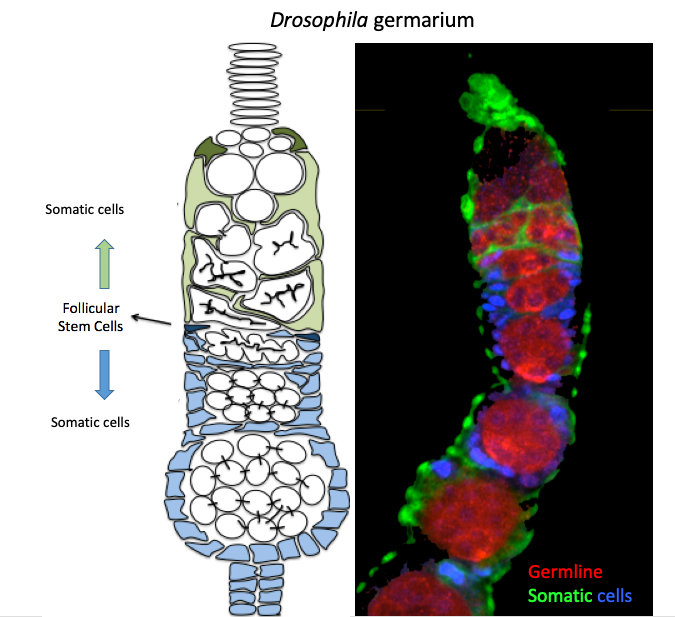Drosophila study offers ground-breaking insights into the mechanisms governing the homeostasis of ovarian somatic stem cells

Diagram of the Drosophila germarium illustrates the presence of follicular stem cells (dark blue) responsible for generating all the somatic cells (green and light blue) that support the female germline (white) (located on the left side of the figure).
A new study conducted in fruit flies (Drosophila) by the Baena-Lopez lab reveals how the body maintains the balance of stem cells in the ovaries. Stem cells are special cells that have the potential to turn into any different cell type in the body. They play a crucial role in keeping our organs healthy and functioning properly. But how are stem cells regulated to ensure the balance and stability of our tissues? It turns out that part of the answer to this question could be in the realm of caspases.
Caspases have traditionally been associated with a process called programmed cell death or apoptosis. However, this recent study by Alessia Galasso and colleagues, published in EMBO Press, has revealed that caspases can also control the behaviour of stem cells in ovaries.
Understanding the functions of caspases has been challenging due to technical limitations – it has been difficult to track their activity and understand their various roles without causing cell death. Lead researcher Prof. Luis Alberto Baena-Lopez explained that the lack of suitable methods to detect non-apoptotic activation of caspases and manipulate their functions has been a major obstacle.
To overcome this challenge, the researchers used advanced genetic techniques in fruit flies to observe and manipulate caspase activation within physiological levels in ovarian stem cells. These experiments uncovered a previously unknown ability of caspases to control the growth and specialization of ovarian stem cells by regulating their communication with other cells and preventing the breakdown of important cell components via autophagy. At a molecular level, this new non-apoptotic function of caspases is related to their control of a signalling receptor called Patched. The researchers also found that some of their findings in fruit flies were also applicable to human ovarian cells.
Alessia Galasso emphasized the significance of these findings, saying, “The specific activation of caspases and its effects are truly fascinating and thought-provoking observations.” However, more research is needed to understand the precise mechanisms by which caspase activation is finely regulated in the ovary and how these new functions are carried out at a molecular level”.
Written by Santosh Kumar (Esashi lab)
Explore more
Read the paper
Non-apoptotic caspase activation ensures the homeostasis of ovarian somatic stem cells
Baena-Lopez Group
The Baena-Lopez group focuses on characterising the molecular mechanisms underlying novel caspase functions beyond apoptosis.
Cell and Developmental Biology
Several Dunn School groups investigate the mechanisms underlying a range of important developmental and cellular processes such as signalling, transcriptional control, cell division, protein trafficking, and genome maintenance.